Plagiarism and self-plagiarism used to be an easy way for career advancement for many ruthless and entitled academics. It became a bit more difficult now, in the times of internet where automatic software can flush out a cheater in a matter of minutes. Provided of course, the scholarly publishers care about such things. And in fact, many don’t. My regular contributor Smut Clyde now presents you the case of two medical plagiarists from Naples in Italy, who became infamous after one of them was caught having stolen the work of a US colleague he was peer reviewing. In other cases, the two Napolitans were even too lazy to plagiarise. They simply republished their already plagiarised “works” several times, and not just as some pedestrian papers, but as book chapters, all in order to boost their publishing record even further. Smut Clyde alerted the journals, but most of them couldn’t care less. To their defence: some are known predatory publishers.
And these are the two Plagiatori di Napoli: Giovanni Tarantino , born 1946, likes to present himself as “Professor of Internal Medicine” at the Università degli Studi di Napoli Federico II, thought the university website has no records of his faculty membership. He was apparently a subordinate group leader there for 20 years till 2005 and might have had afterwards an adjunct professorship under a Napoli faculty member Giovanni Di Minno, whom Tarantino invited to join the plagiarism game. Their common paper in Oncotarget disappeared from the internet without a trace when the misconduct became known. Tarantino’s junior partner in the plagiarism scam is Carmine Finelli, educated at the same university, last (allegedly) affiliated with the hospital Stella Maris Mediterraneo in Puglia and now a “free medical professional”, whatever that might be.
Italian Text Transplants, by Smut Clyde
With all the developments and retractions and cruelly-truncated research programs in the field of regenerated airway transplants, it is easy to overlook the parallel events involving ‘text transplants’. I refer of course to the experiments of Dr Carmine Finelli and his colleague and mentor Dr Giovanni Tarantino, as reported in posts at RetractionWatch and by Sylvie Cotaud at Ocasapiens.
Finelli rose to prominence 18 months ago in L’affair Dansinger when a paper he had published seemed familiar to one of its readers. The reader had in fact written identical sentences and tabulated identical data, at an earlier date, but his own version had been rejected for publication (by a panel of peer reviewers which included Carmine Finelli). Soon a commenter named ‘Marco’ reported that Finelli & Tarantino (2013) was a near-verbatim copy of Wang et al. (2009) (although augmented by the addition of a paragraph of Concluding Remarks, copied from the Abstract of a paper from 2001). The commotion drew the attention of commenters and contributors to PubPeer, who delight in pursuing low-hanging fish and fruit in a barrel, and who doubted that the episode would be an isolate.
The results of their inquiries are documented in 36 threads at PubPeer: 21 co-authored by Finelli and Tarantino, three by Finelli (plus other colleagues and students) and 12 by Tarantino. The dates range from Tarantino (2007) to Finelli (2017), with their productivity peaking in 2013 with nine papers and 2014 with eight. In short, the experiments of the Dottori were all about taking blocks of text (of greater or shorter length) from donor papers, decellularising them stripping out the references, and re-seeding the resulting “scaffold” with stem cells citations of their own previous publications.
You will have to read the PubPeer threads themselves to decide how far the papers depart from conventional standards of originality. In the first two examples above, the re-authored source material was republished in undigested form. At the other extreme are lapidary mosaics of paragraphs woven together from multiple sources (to the extent that a mosaic can be woven): sometimes just Abstracts, with no indication that the main texts of these papers had been consulted. Or nuggets or inclusions of source material, embedded in connective tissue (e.g. Finelli et al. 2014a and 2014b, which are the same collage in two different journals).* Sometimes journal editors will curate an issue with an Editorial that picks out the significant contributions, bookended by introductory and concluding paragraphs that put them in context and abstract their recurring themes. These prefaces can be stripped of the contribution-specific descriptions and repurposed as perfectly republishable artifacts in their own right.
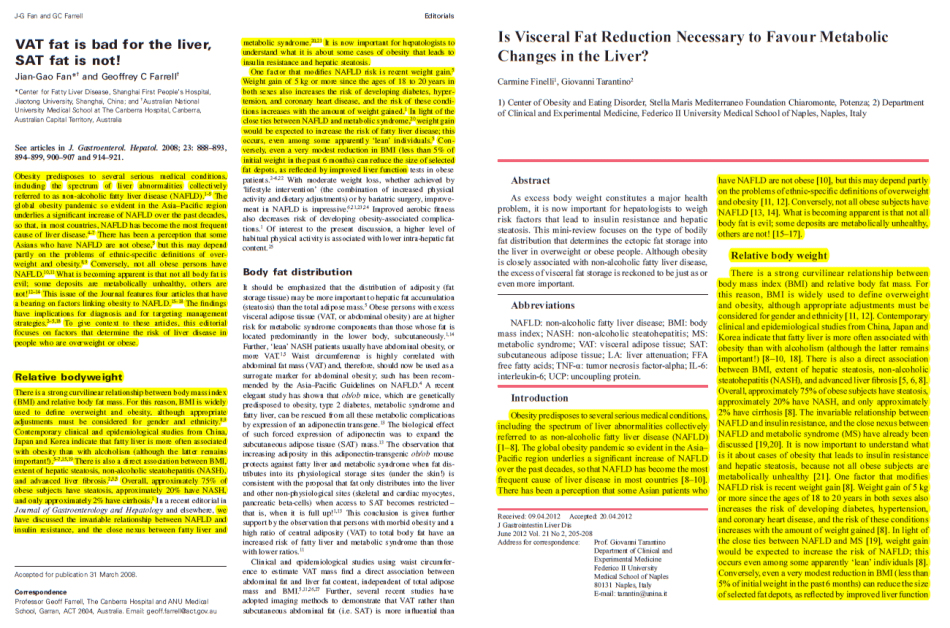
The works include review articles and Invited Editorials. Also of note, and exemplifying the “lapidary mosaic” style, are two scrapbooked Chapters in the Handbook of Lipids in Human Function (2016) and a third for Nutrition in the Prevention and Treatment of Abdominal Obesity (2014). Ronald Watson, editor of both books, presumably commissioned the chapters.* There is a lesson here for young scholars, about the kind of academic conduct by which one builds a magisterial reputation in the field… how one earns invitations to write Editorials, and to be a peer reviewer.
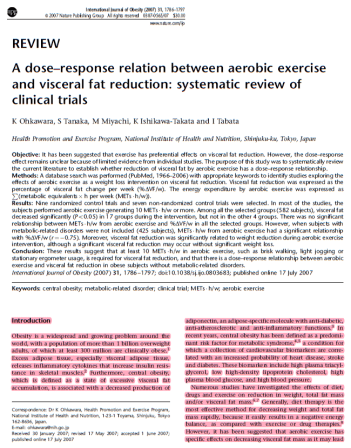

The World Journal of Gastroenterology was a favourite target, with 14 flagged publications (seven of them without Finelli). This hails from Baishideng Publishing Group, a pay-to-play company noted for spamming and negotiable standards of review. Second favourite was Journal of Gastrointestinal and Liver Diseases (the organ of several Romanian medical associations) with five co-authored papers.
In 2013, the editors of J. Gastroint. Liver Dis. were compelled to reprimand Finelli and Tarantino for including an antepenultimate paragraph in their 2012 contribution, without attributing Zelber-Sagi et al. (2011) as the authors. This being “minor plagiarism with inadequate attribution in an already published review”, the authors were let off with an apology and a promise to go forth and sin no more, while the editors will engage in no further correspondence, for they feel that they have discharged their obligations. The ironic aspect of this single recycled paragraph is that it is almost the only paragraph in Finelli & Tarantino (2012) that was not taken from Zivkovic et al. (2007).
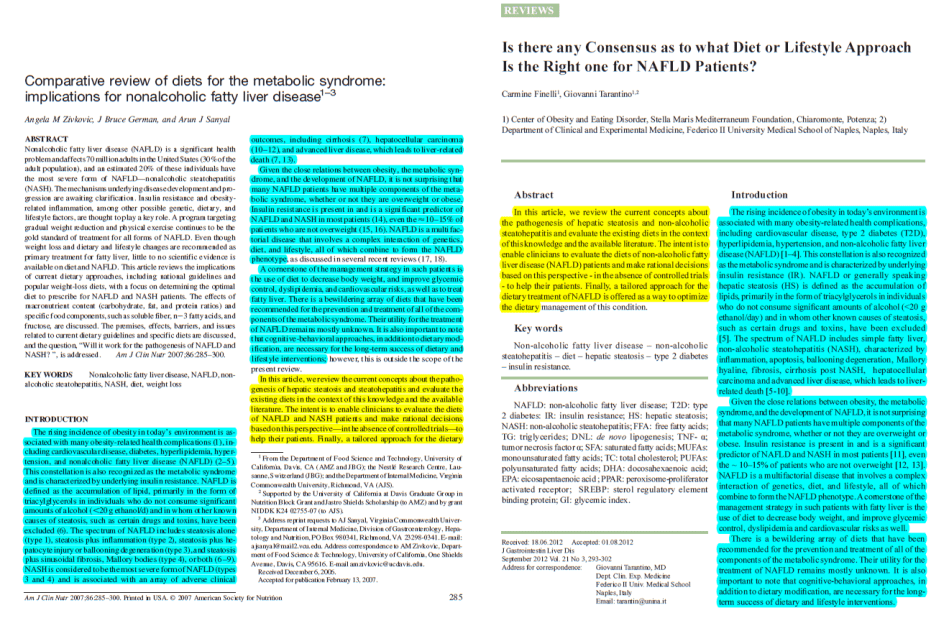
In one form or another, paragraphs from Zivkovic et al. can be found in half-a-dozen of the doctors’ works in the medium of collage. They were especially besotted with its introductory phrases (“The rising incidence of obesity in today’s environment is associated with many obesity-related health complications…” and “This constellation is also recognized as the metabolic syndrome and is characterized by underlying…”), e.g. Tarantino, Capone & Finelli (2013); Finelli & Tarantino (2014); and Tarantino & Finelli (2016).
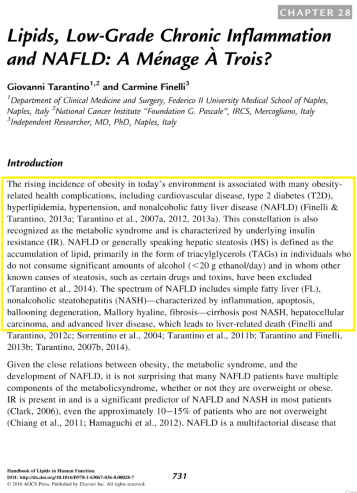

Another productive text-mine was Harrison & Day (2007). It provided the bulk of a review article, Finelli & Tarantino (2012), although when the Figures were redrawn for that 2012 appearance they lost much of their aesthetic elegance.

Other paragraphs reappeared in Finelli, Gioia & La Sala (2012), and as a subsection in a 2014 Chapter. It so happened that Harrison and Day had committed a harmless but distinctive malapropism, which was faithfully copied in each emergence, making them easy to find.
I could go on. A summary from Cai et al. (2006) was recreated five times, including Tarantino & Finelli (2016) again (for that chapter is something of a greatest-hits compilation): not necessarily a record but still an accomplishment to celebrate. It may be that after the first few repetitions, the authors genuinely believed that they were merely copying their own unimprovable bons mots. Other sources ranged from Wikipedia to Dr Mehmet Oz. As well as text, Tables and Figures were fair game.
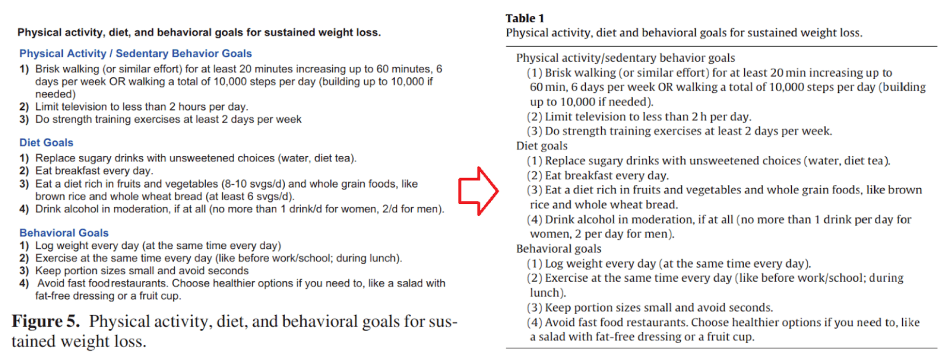

Meanwhile, science blogger Neuroskeptic had reported the discouraging outcomes of an experiment in editorial receptivity:
Over the space of four months, I reported about 30 cases of plagiarism in review papers to various journals, with the help of Turnitin plagiarism detection software.
Every case I reported was a serious one. The percentage of unoriginal text ranged from 44-90%, with an average of about 65%.
I was inspired by this example to conduct a similar project with the present oeuvre, selecting 18 papers from 13 journals and emailing the editors, drawing their attention to these questions of originality and attribution (this sounds so much better than “anonymous poison-pen denunciations”). I assured the recipients that our correspondence (or their lack of response) would be confidential.
In 11 of 18 cases my email was acknowledged, with some editors asking for further information or promising to conduct an inquiry. Less encouragingly, only two of the 18 have experienced an actual change in status. It may be that a 16-month interval is not long enough for journals to compare two blocks of text, or to obtain the authors’ consent to an intervention. However, I am not counting the case of Finelli, Gioia & La Sala (2012) where my message was superfluous, as the editors had already been notified and were already taking steps. Nor did my list include Tarantino, Di Minno & Finelli (2015), which the editors of Oncotarget retracted depublished without prompting, leaving no explanation or trace of its previous existence.
In “Rivers of London“, Dr Walid knows the score:
When I asked Dr Walid about it, he merely said that he liked to keep certain of his files secure.
‘From who?’ I asked.
‘Other researchers,’ he said. ‘They’re always looking to pirate my work.’ Apparently the hepatologists were the worst.
* Finelli et al. (2014a / 2014b) reappeared in an extended dance remix as a book chapter in 2017 — gaining some additional copy-paste though losing the co-authors — though no-one bothered to annotate the piracy, for the publisher in this case was Bentham, who are unlikely to care.

Donate!
If you are interested to support my work, you can leave here a small tip of $5. Or several of small tips, just increase the amount as you like (2x=€10; 5x=€25). Your generous patronage of my journalism will be most appreciated!
€5.00




To steal works is very common…to publish the same multiple times I also picked up in the past one or two it was somehow like an accepted method of working ….obviously all of this is very easy with the help of certain publishers just begging for money
LikeLiked by 1 person
Reblogged this on Wissenschaft als Beute and commented:
This is the way, how to become a Max Planck director.
https://translate.google.com/translate?hl=en&sl=de&tl=en&u=https%3A%2F%2Fwissenschaftalsbeute.wordpress.com%2F2018%2F01%2F11%2Fdie-krise-der-max-planck-gesellschaft-gesellschaft-auf-abwegen-2%2F&sandbox=1
LikeLike
Yours was an odd article. Perhaps it was due to the effects of GoogleTranslate but charges such as, “…MPG involuntarily advocates a science policy aimed at political control of research,” are grasping at straws.
LikeLike
Hi Leonid
My first thought upon reading the title “Tarantino…” made me instantaneously think of Pulp Fiction.
Guess i wasn’t too wrong with that 🙂
Cheers, oliver
LikeLiked by 1 person
“Finelli et al. 2014a and 2014b, which are the same collage in two different journals”
Another colour-coded depiction of the first three pages (after that I got bored):

LikeLike
Good work Smut Clyde!
LikeLike
“free medical professional” is a translation of “medico libero professionista” i.e. private practice.
LikeLike
At least 4 more missing articles in Oncotarget. They are not visible in the table of contents but can be still found on Pubmed.
Vol 7, No 31
http://www.oncotarget.com/index.php?journal=oncotarget&page=issue&op=view&path%5B%5D=172 … …
Missing pages after 49887
https://www.ncbi.nlm.nih.gov/pubmed/27340783
Vol 7, No 28
http://www.oncotarget.com/index.php?journal=oncotarget&page=issue&op=view&path%5B%5D=169 … …
Missing pages after 43628
https://www.ncbi.nlm.nih.gov/pubmed/27248319
Vol 6, No 13
http://www.oncotarget.com/index.php?journal=oncotarget&page=issue&op=view&path%5B%5D=112 … …
Missing pages after 11433
http://www.oncotarget.com/index.php?journal=oncotarget&page=article&op=view&path%5B%5D=16998 …
https://www.ncbi.nlm.nih.gov/pubmed/25825984
Vol 6, No 14
http://www.oncotarget.com/index.php?journal=oncotarget&page=issue&op=view&path%5B%5D=113 … …
Missing pages after 12480
https://www.ncbi.nlm.nih.gov/pubmed/25980579
LikeLike
Pingback: La banda Tarantino-Finelli? Sta bene, grazie - Ocasapiens - Blog - Repubblica.it